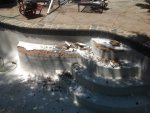I was cleaning and planing to fill the pool this weekend (along with replacing the pump) and noticed some air bubbles coming up from a crack in the steps. The plan was to open up the cracks, use repair plaster to fill, and consider a complete re-plastering in the fall. Unfortunately, as I started taping and exploring the size of the delaminination it became apparent that the edges of the steps are in pretty bad shape, and when I started to chisel away at them large chunks came off - basically bridging the cracks on the top of the steps and the cracks on the front of the steps.
This leaves me with a few questions:
1. The inside of the steps seems to be a sand-mix type concrete, rather than gunite. It's brown, not grey. Does that make sense? Is the shell of the pool blown in and then the steps formed, and then everything plastered?
2. The white plaster layer is amazingly thin - perhaps 1/16 - 1/32 of an inch. Is that normal? Is the white part the only plaster, and the grey gunite?
3. Has this become outside the scope of a do it yourself-er? I'm reasonably well skilled, although I'm unclear as to the right way to fix the steps. Could I do a rough coat of bonding cement, and then a skim coat of white plaster and have something that won't leak? Is the fact that I'm asking this question proof I should just write a check?
Thanks!

This leaves me with a few questions:
1. The inside of the steps seems to be a sand-mix type concrete, rather than gunite. It's brown, not grey. Does that make sense? Is the shell of the pool blown in and then the steps formed, and then everything plastered?
2. The white plaster layer is amazingly thin - perhaps 1/16 - 1/32 of an inch. Is that normal? Is the white part the only plaster, and the grey gunite?
3. Has this become outside the scope of a do it yourself-er? I'm reasonably well skilled, although I'm unclear as to the right way to fix the steps. Could I do a rough coat of bonding cement, and then a skim coat of white plaster and have something that won't leak? Is the fact that I'm asking this question proof I should just write a check?
Thanks!


